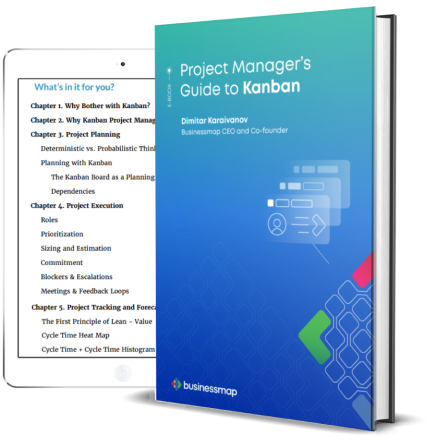The Kanban method is an advanced set of principles and practices combined with artifacts to visualize your workflow. At first sight, it seems like a simple way of mapping the stages of your work process, but there is more than half of a century worth of theory and experimentation that brought it to your desktop.
Please get to know the Kanban terminology and learn everything about the Kanban concept and the people that developed it in our Kanban Encyclopedia.
Fundamental Kanban Terms Not to Miss
Kanban
The word literally means ‘signboard’ or ‘visual card’. In the late 1940s, it became a term for Toyota’s inventory management system and later evolved as a process management method.
Kanban system
The Kanban system originated as a scheduling system for lean manufacturing and just-in-time manufacturing (JIT). It was an inventory-control system used for the supply chain by Toyota’s engineer Taiichi Ohno.
The Kanban Method
David J. Anderson formulated the Kanban Method for knowledge work and service work in 2005. He combined elements of the work of W Edwards Deming, Eli Goldratt, Peter Drucker, and Taiichi Ohno. It incorporates concepts such as pull systems, queuing theory, flow, and a set of Kanban principles and practices.
Foundational Principles
- Start with what you do now
- Agree to pursue evolutionary change
- Respect current roles, responsibilities & job titles
- Encourage acts of leadership at all levels.
Core Practices
- Visualize
- Limit WIP
- Manage flow
- Make policies explicit
- Implement feedback loops
- Improve collaboratively, evolve experimentally (using models and the scientific method)
Kanban Board
A Kanban board is one of the tools to implement the Kanban method. The board is divided into a minimum of 3 columns – Requested, In Progress, Done, representing a process's stages.
Kanban boards can be physical or electronic. The main idea is to visualize the path of tasks from request to completion and see where the bottlenecks are.
 Basic Kanban Board
Basic Kanban Board
Kanban Card
In Kanban, tasks are visually represented by cards. Each Kanban card is a work item, moving through the columns on the Kanban board. Cards contain information about the work item. They are not different in size because the idea is to break a project down to its smallest tasks and complete them quickly.
 Digital Kanban Card
Digital Kanban Card
Swimlane
Swimlanes are the horizontal divisions of a kanban board, helping to optimize the workflow. The columns represent stages, and swimlanes categorize work. Swimlanes can be used to represent teams, classes of service, priority, etc.
WIP
WIP, or Work In Progress, refers to the amount of work being started, regardless of the subcolumn it is currently in.
WIP Limits
Setting limits on the work in progress is a strategy to avoid overworking and context switching while focusing on the important things. Applying WIP limits is the second core practice in Kanban and ensures a healthy flow.
 Digital Kanban Board with WIP Limits
Digital Kanban Board with WIP Limits
Kanban Cadence
There are 7 Kanban Cadences – the cyclical meetings that drive evolutionary change and “fit for purpose” service delivery.
- Risk Review (monthly)
- Strategy Review (quarterly)
- Service Delivery Review (weekly)
- Operations Review (monthly)
- Standup Meetings (daily)
- Replenishment Meeting (weekly)
- Delivery Planning Meeting (per delivery cadence)
 Kanban cadences
Kanban cadences
Portfolio Kanban
The Portfolio Kanban is a holistic method that aims to improve an organization’s ability to deliver by applying the principles of visualization, limiting work in progress, and flow management on a system level.
The main difference between the Portfolio Kanban method and the Team Kanban method is that the Kanban cards on a Portfolio Kanban board are “parents” of one or many Kanban cards that live on the Team Kanban board.
Kanban Software
The purpose of the Kanban software is to ensure better visualization of the workflow. In comparison to classical project management software, it provides more flexibility and takes less time to administrate. Kanban software enhances team communication, generates metrics, and helps improve processes and increase predictability.
Kanban Metrics Glossary
Kanban metrics aim to improve the process's predictability. The most important metrics to monitor are throughput, WIP, cycle time, and lead time.
Throughput
Throughput is the number of items passing through a system or process. According to Little’s Law, Average Throughput = Average WIP divided by average cycle time. The throughput of your team is a key indicator showing whether your process is productive or not.
Cycle Time
Cycle time begins when the new arrival enters the “in progress” stage, and somebody is actually working on it until it enters the Done column.
Lead Time
This is the period between a new task’s appearance in your workflow and its final departure from the system.
CFD (Cumulative Flow Diagram)
The cumulative flow diagram is one of the most useful analytical tools in Kanban systems. Kanban software could provide it as a built-in tool. It tracks the three kanban metrics – throughput, cycle time, and WIP and presents data visually and concisely.
 Example of CFD
Example of CFD
Little’s Law
Average Cycle Time = Average Work In Progress / Average Throughput
Little’s law locks the three measures (WIP, throughput, and cycle time) together uniquely and consistently for any system to which it applies.
However, it was originally stated in a slightly different form:
Average Items In Queue = Average Arrival Rate * Average Wait Time
This fact is important because different assumptions need to be satisfied depending on which form of the law is being used.
10 Years Kanban Experience In 1 Free Book.
Project Manager's Guide to Kanban
Other Relevant Kanban Terms Explained
Agree to Pursue Continuous Improvement
The second Kanban principle, ‘agree to pursue incremental, evolutionary change’, emphasizes that for successful implementation, there needs to be an agreement on a slow, gentle, evolutionary, incremental approach. Otherwise, there won’t be the right environment or management support for a Kanban initiative.
Blocker
Blocker is the reason that blocks a card on the Kanban board. Whatever keeps it from progressing towards completion can be a blocker. Some frequent reasons are “not enough information”, “personal capacity”, “expedite issue”, among others.
Blocker Clustering
Blocker clustering is a technique for analyzing blockages. Different reasons for blocked work are grouped, and the cause is determined for each group; it becomes like a cluster around it. Clustering emphasizes that blockades have a cost. This is a strategy for improving and future avoidance of quantified blockages.
For example, within the two large categories “internal and external blockades”, we often see clusters such as “dependent story”, “missing requirements”, “environment not available” and “product owner not available”.
Cost of Delay
The Cost of Delay is a way of communicating the impact of time on the outcomes we hope to achieve. More formally, it is the partial derivative of the total expected value with respect to time.
The cost of Delay combines urgency and value—two things that are not very easy to distinguish between. To make decisions, we need to understand not just how valuable something is but also how urgent it is.
CONWIP
Technically, the bracketing of a single WIP limit across the system is known as a CONWIP (for “constant Work-In-Progress”). A CONWIP is a form of pull system and applied within a mature Kanban system and works very well.
Encourage Leadership at All Levels
The most recent fourth principle of the Kanban Method is ‘encourage acts of leadership at all levels’. Leadership is an important catalyst for change, and people are more likely to improve in a culture of safety and empowerment.
Explicit Policies
The fourth Kanban practice says, ‘make policies explicit’. As the method revolves around a common agreement to pursue incremental and evolutionary change, this is one of the first things to do. Making policies explicit facilitates consensus around improvement suggestions and minimizes the chance of misconceptions and lack of understanding.
Evolve Experimentally
The sixth practice of the Kanban Method is fully formulated as ‘improve collaboratively, evolve experimentally (using models/ scientific method)’. If a team has a shared understanding of theories about work, workflow, process, and risk, it is more likely to build a shared comprehension of a problem and suggest improvement actions that can be agreed upon.
There are three useful models suggested by David J. Anderson:
- The Theory of Constraints (the study of bottlenecks)
- The Theory of Profound Knowledge (a study of variation and how it affects processes)
- Lean Economic Model (based on the concepts of “waste”)
Feedback Loops
Feedback loops represent the circulation of information and change between the 7 cadences. The relationships are shown visually in the picture above.
Sometimes, teams call their meetings feedback loops for simplicity, although the meaning is truly the interactions between them.
Flow Management
Managing flow is the third Kanban practice that refers to monitoring and measuring flow. Flow is the movement of work items from request to completion.
Fast and smooth flow means that a system creates value quickly, minimizing risk and avoiding the cost of delay. It is also doing so in a predictable fashion.
JIT
The abbreviation stands for Just In Time. Just-in-time manufacturing/production is a methodology aimed primarily at reducing cycle times within the production system. It originated in Japan, largely in the 1960s and 1970s, and particularly at Toyota.
Kaizen
Kaizen is the Japanese word for “continuous improvement”. It has evolved as a business term in post-WW2 Japan, describing a business practice to improve processes and eliminate waste, most notably in Toyota.
Pull System
A pull system is a lean manufacturing strategy used to reduce waste in the production process. Components used in the manufacturing process are only replaced once they have been consumed, so companies only make enough products to meet customer demand.
In management, it means that no new work is started until started items are finished. When there is capacity, a new item is pulled to ‘In Progress’.
Pull Policy
A pull policy within a pull system sets the process requirements – the order in which work is to be pulled, where from, and how much.
Respect Current Roles
The third Kanban principle is to ‘Respect current roles and positions.’ This means not making changes in the formal structure within an organization when implementing Kanban. It can be applied to the existing process. By agreeing to respect current roles, responsibilities, and job titles, we eliminate initial fears.
Start Where You Are
The Kanban principle states, ‘Start with what you do now.’ The Kanban Method does not require changes to the process. It is based on the concept that the current process evolves and improves.
Visualization
The first Kanban practice is to visualize the workflow. This is the primary function of the Kanban board and the best way to obtain information about a process and analyze the data. It is the first step in proceeding with the other principles.
Significant Figures
Taiichi Ohno
Taiichi Ohno was a businessman and an industrial engineer at Toyota, known as the Father of the Toyota Production System, which became the Lean manufacturing foundation.
Early in his career, he expanded upon the JIT concepts developed by Kiichito Toyoda to reduce waste and started experimenting with and developing methodologies to produce needed components promptly to support the final assembly. This way, he developed kanban to improve manufacturing efficiency. He identified the 7 wastes (or Muda in Japanese) of Lean.
“Progress cannot be generated when we are satisfied with existing situations”.
Sakichi Toyoda
Sakichi Toyoda was a Japanese inventor, industrialist, and the founder of Toyota Industries Co., Ltd.
He invented a power loom in 1902 and, in 1926, an automatic loom capable of detecting a snapped thread that automatically stopped the loom, thus preventing the production of poor quality. This principle of autonomous automation is known as the Jidoka principle and became a part of the Lean methodology.
“I’m not talented more than anybody else. I just put lots of effort and researches.”
David J. Anderson
David J. Anderson is a thought leader in managing effective technology development. He is a pioneer of the use of kanban systems for improved service delivery in professional services businesses. David Anderson is the originator of the Kanban Method and for improved service delivery and strategy.
“People ask me, “What is the difference between lean and kanban?” Answer: lean is a destination; kanban is a means to get there.”
Businessmap is the most flexible software
to align work with company goals
In Summary
By reaching the end of the Kanban encyclopedia, you've learned everything that a novice Kanban practitioner should know. Keep on learning and stop by from time to time to freshen your knowledge.





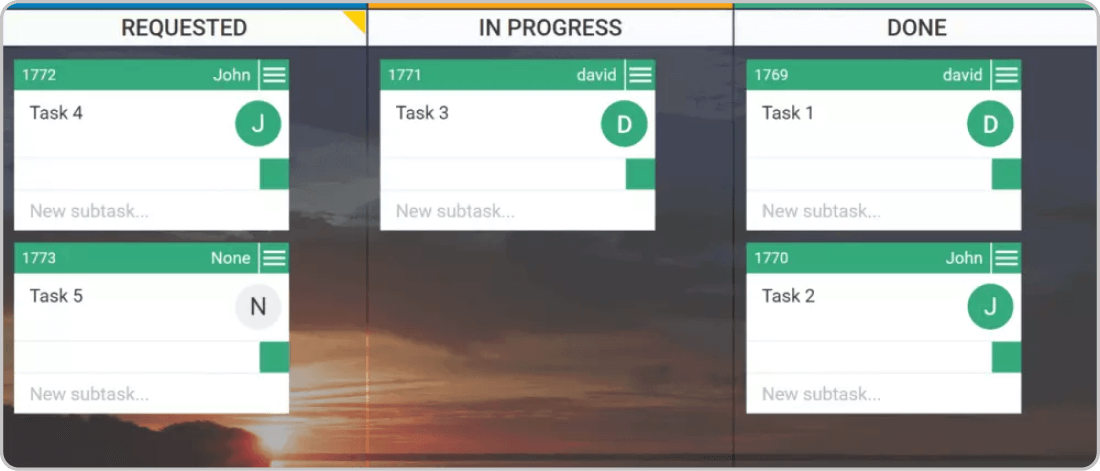 Basic Kanban Board
Basic Kanban Board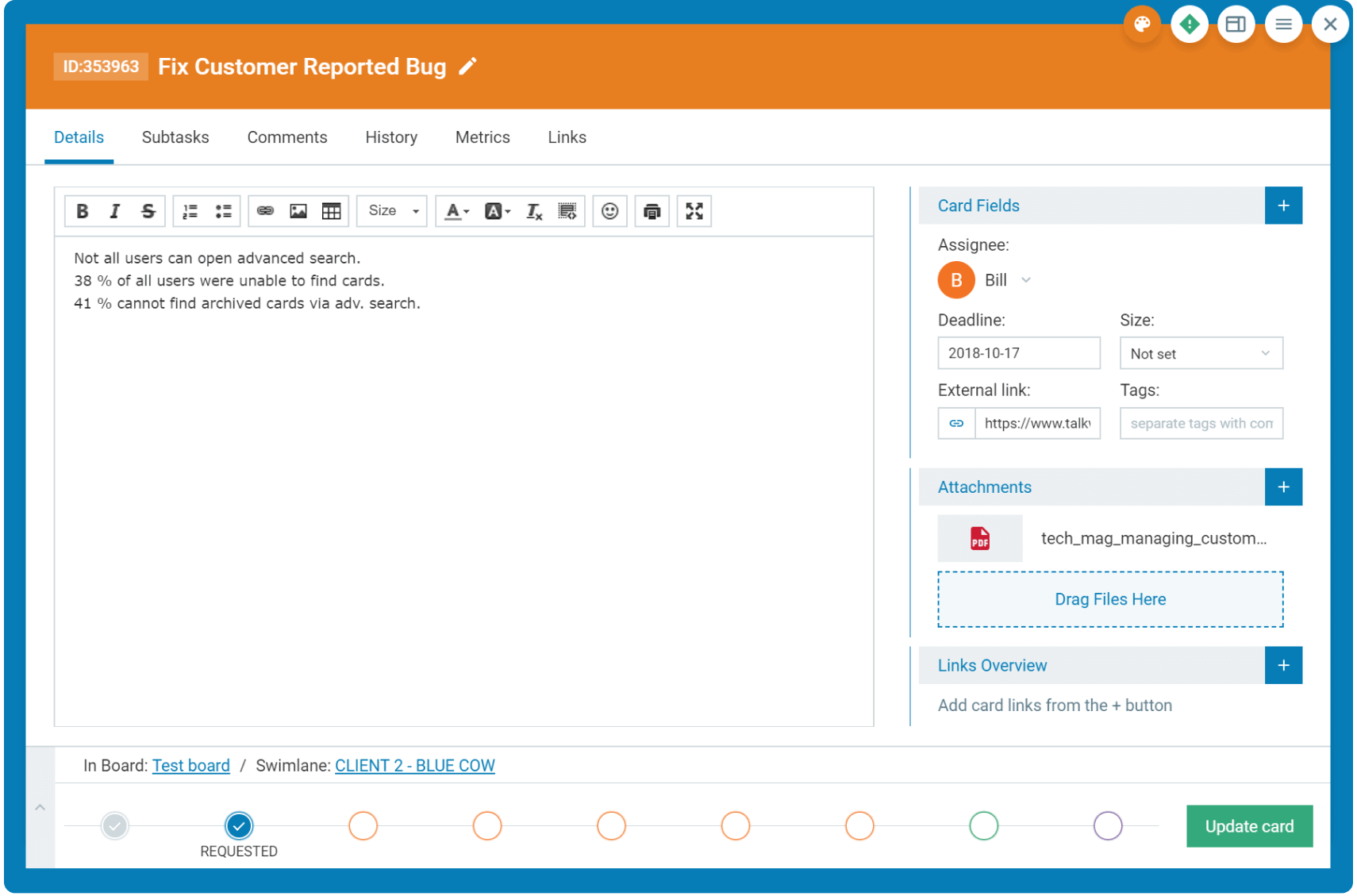 Digital Kanban Card
Digital Kanban Card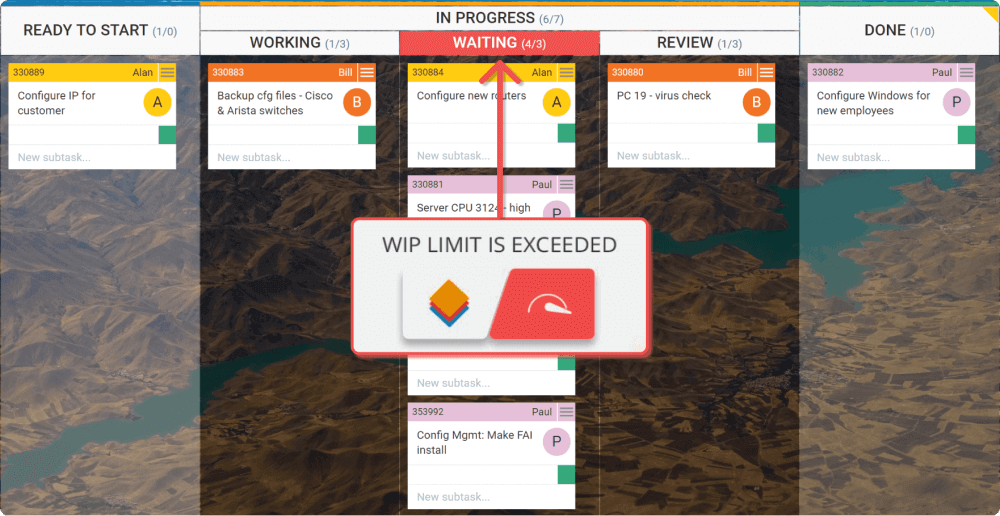 Digital Kanban Board with WIP Limits
Digital Kanban Board with WIP Limits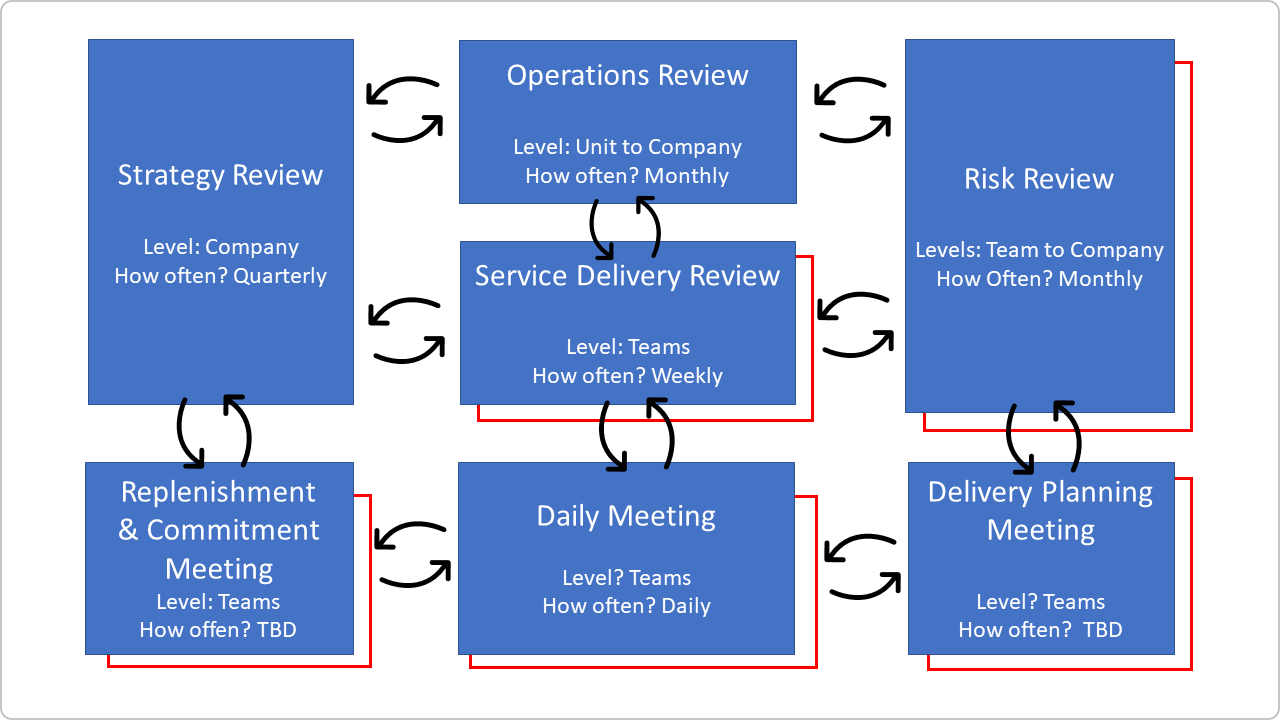 Kanban cadences
Kanban cadences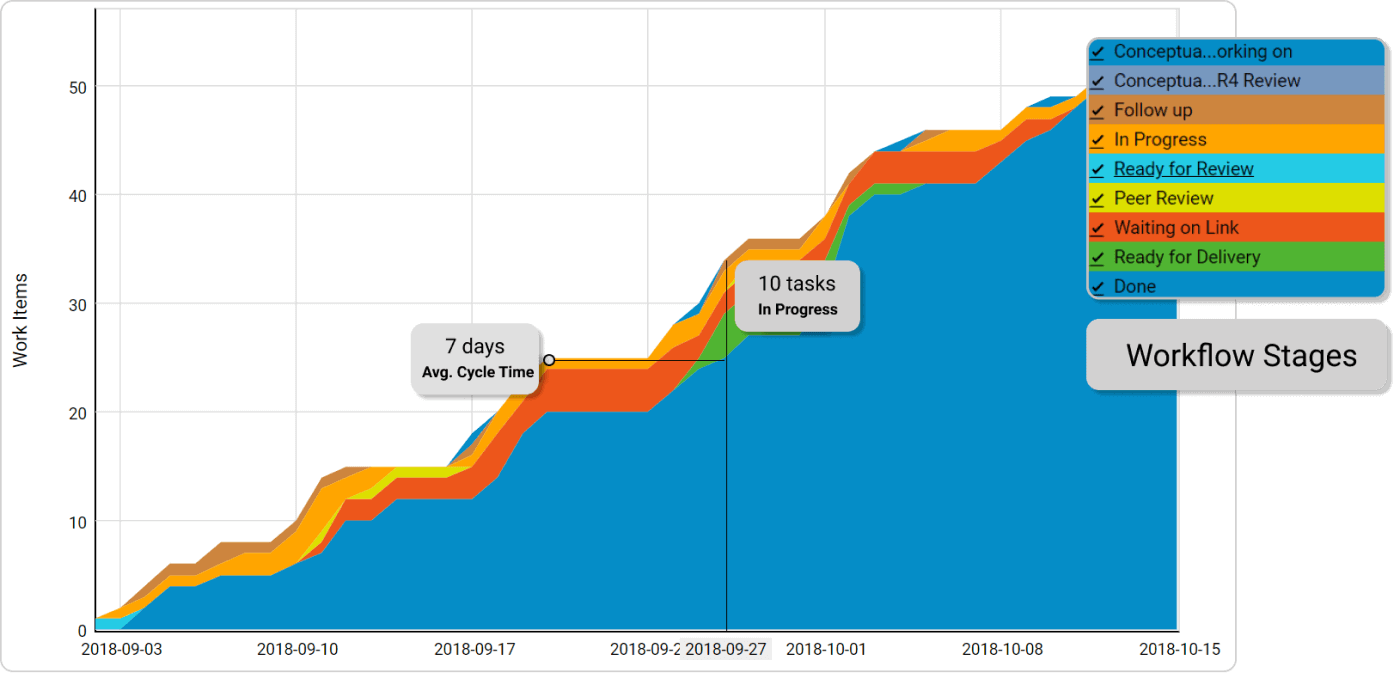 Example of CFD
Example of CFD